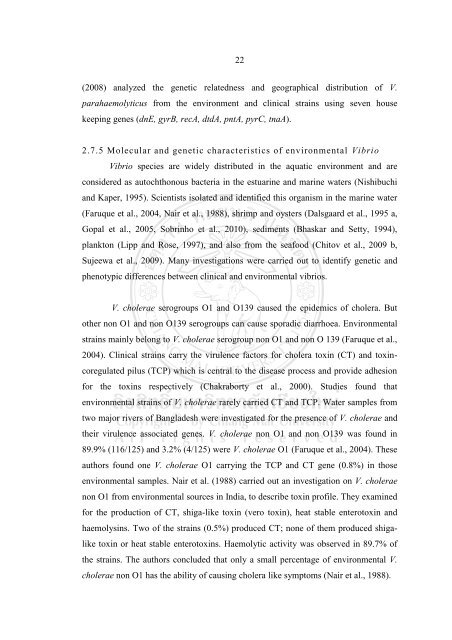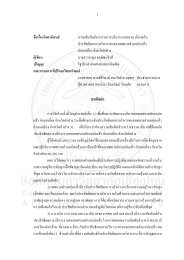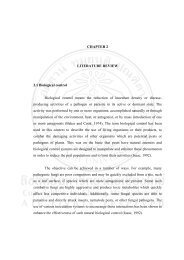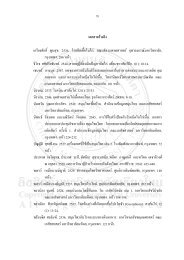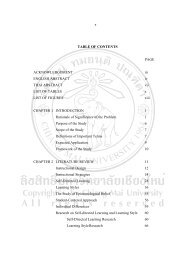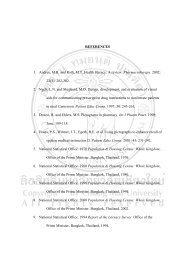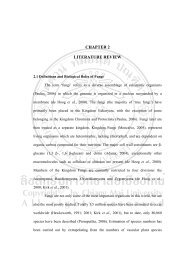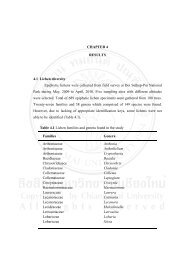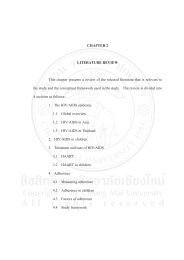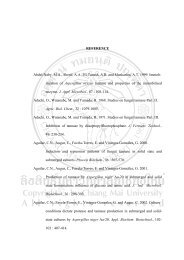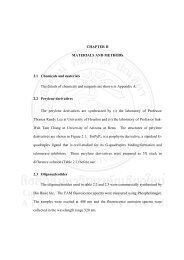prevalence and molecular characteristics of vibrio species in pre ...
prevalence and molecular characteristics of vibrio species in pre ...
prevalence and molecular characteristics of vibrio species in pre ...
You also want an ePaper? Increase the reach of your titles
YUMPU automatically turns print PDFs into web optimized ePapers that Google loves.
22<br />
(2008) analyzed the genetic relatedness <strong>and</strong> geographical distribution <strong>of</strong> V.<br />
parahaemolyticus from the environment <strong>and</strong> cl<strong>in</strong>ical stra<strong>in</strong>s us<strong>in</strong>g seven house<br />
keep<strong>in</strong>g genes (dnE, gyrB, recA, dtdA, pntA, pyrC, tnaA).<br />
2.7.5 Molecular <strong>and</strong> genetic <strong>characteristics</strong> <strong>of</strong> environmental Vibrio<br />
Vibrio <strong>species</strong> are widely distributed <strong>in</strong> the aquatic environment <strong>and</strong> are<br />
considered as autochthonous bacteria <strong>in</strong> the estuar<strong>in</strong>e <strong>and</strong> mar<strong>in</strong>e waters (Nishibuchi<br />
<strong>and</strong> Kaper, 1995). Scientists isolated <strong>and</strong> identified this organism <strong>in</strong> the mar<strong>in</strong>e water<br />
(Faruque et al., 2004, Nair et al., 1988), shrimp <strong>and</strong> oysters (Dalsgaard et al., 1995 a,<br />
Gopal et al., 2005, Sobr<strong>in</strong>ho et al., 2010), sediments (Bhaskar <strong>and</strong> Setty, 1994),<br />
plankton (Lipp <strong>and</strong> Rose, 1997), <strong>and</strong> also from the seafood (Chitov et al., 2009 b,<br />
Sujeewa et al., 2009). Many <strong>in</strong>vestigations were carried out to identify genetic <strong>and</strong><br />
phenotypic differences between cl<strong>in</strong>ical <strong>and</strong> environmental <strong>vibrio</strong>s.<br />
V. cholerae serogroups O1 <strong>and</strong> O139 caused the epidemics <strong>of</strong> cholera. But<br />
other non O1 <strong>and</strong> non O139 serogroups can cause sporadic diarrhoea. Environmental<br />
stra<strong>in</strong>s ma<strong>in</strong>ly belong to V. cholerae serogroup non O1 <strong>and</strong> non O 139 (Faruque et al.,<br />
2004). Cl<strong>in</strong>ical stra<strong>in</strong>s carry the virulence factors for cholera tox<strong>in</strong> (CT) <strong>and</strong> tox<strong>in</strong>-<br />
coregulated pilus (TCP) which is central to the disease process <strong>and</strong> provide adhesion<br />
for the tox<strong>in</strong>s respectively (Chakraborty et al., 2000). Studies found that<br />
environmental stra<strong>in</strong>s <strong>of</strong> V. cholerae rarely carried CT <strong>and</strong> TCP. Water samples from<br />
two major rivers <strong>of</strong> Bangladesh were <strong>in</strong>vestigated for the <strong>pre</strong>sence <strong>of</strong> V. cholerae <strong>and</strong><br />
their virulence associated genes. V. cholerae non O1 <strong>and</strong> non O139 was found <strong>in</strong><br />
89.9% (116/125) <strong>and</strong> 3.2% (4/125) were V. cholerae O1 (Faruque et al., 2004). These<br />
authors found one V. cholerae O1 carry<strong>in</strong>g the TCP <strong>and</strong> CT gene (0.8%) <strong>in</strong> those<br />
environmental samples. Nair et al. (1988) carried out an <strong>in</strong>vestigation on V. cholerae<br />
non O1 from environmental sources <strong>in</strong> India, to describe tox<strong>in</strong> pr<strong>of</strong>ile. They exam<strong>in</strong>ed<br />
for the production <strong>of</strong> CT, shiga-like tox<strong>in</strong> (vero tox<strong>in</strong>), heat stable enterotox<strong>in</strong> <strong>and</strong><br />
haemolys<strong>in</strong>s. Two <strong>of</strong> the stra<strong>in</strong>s (0.5%) produced CT; none <strong>of</strong> them produced shiga-<br />
like tox<strong>in</strong> or heat stable enterotox<strong>in</strong>s. Haemolytic activity was observed <strong>in</strong> 89.7% <strong>of</strong><br />
the stra<strong>in</strong>s. The authors concluded that only a small percentage <strong>of</strong> environmental V.<br />
cholerae non O1 has the ability <strong>of</strong> caus<strong>in</strong>g cholera like symptoms (Nair et al., 1988).


